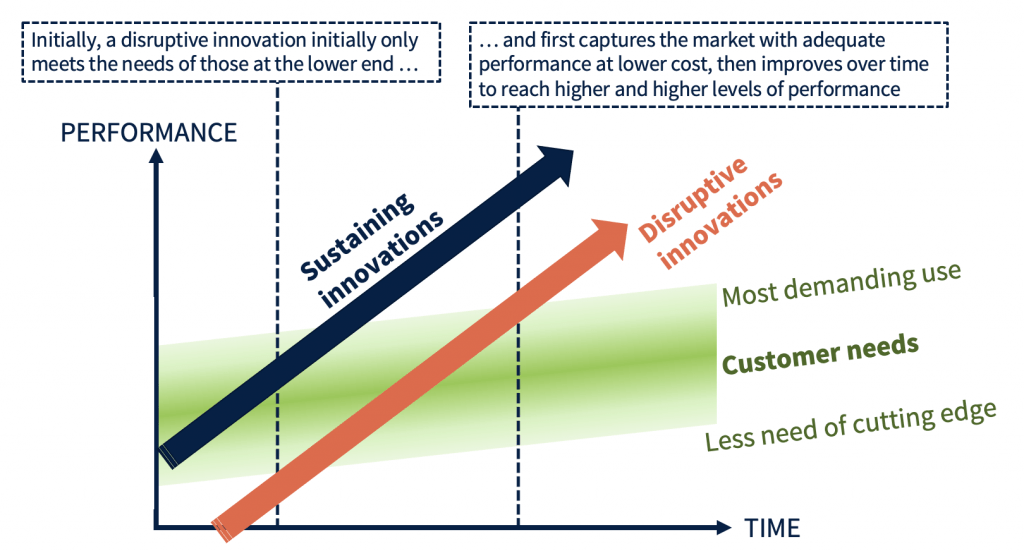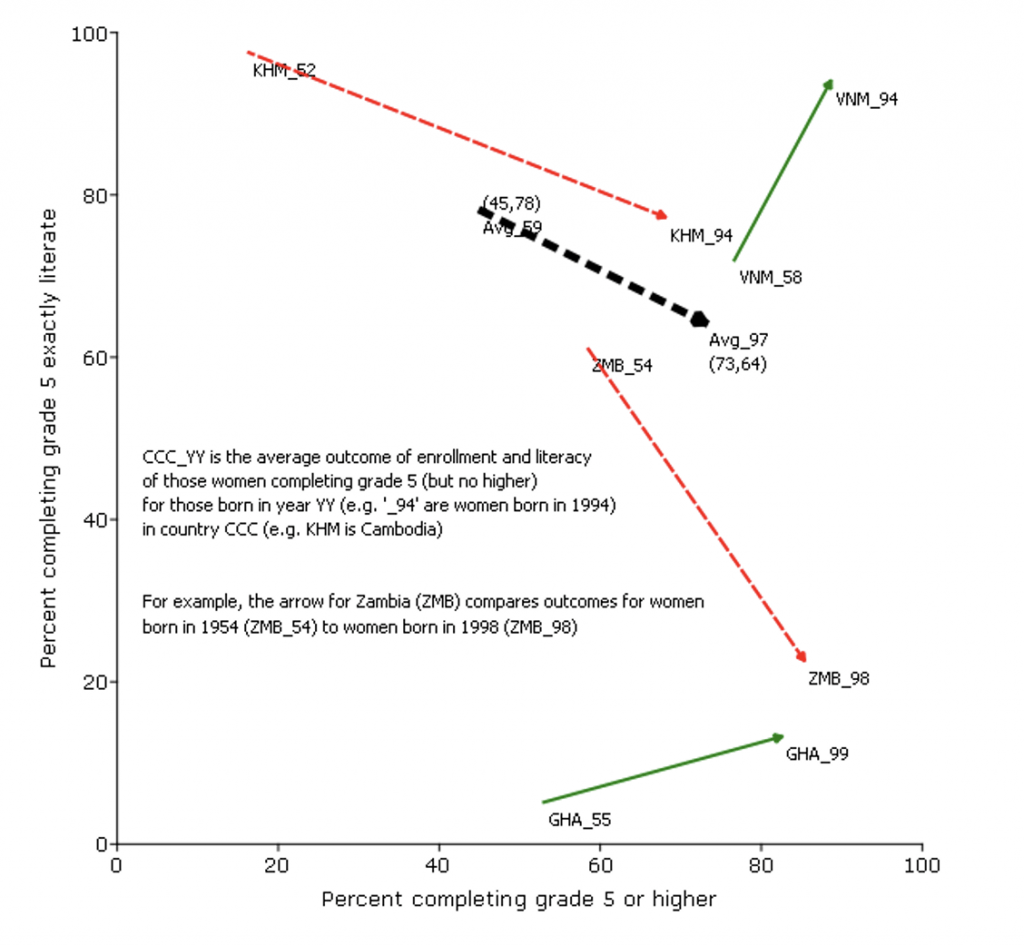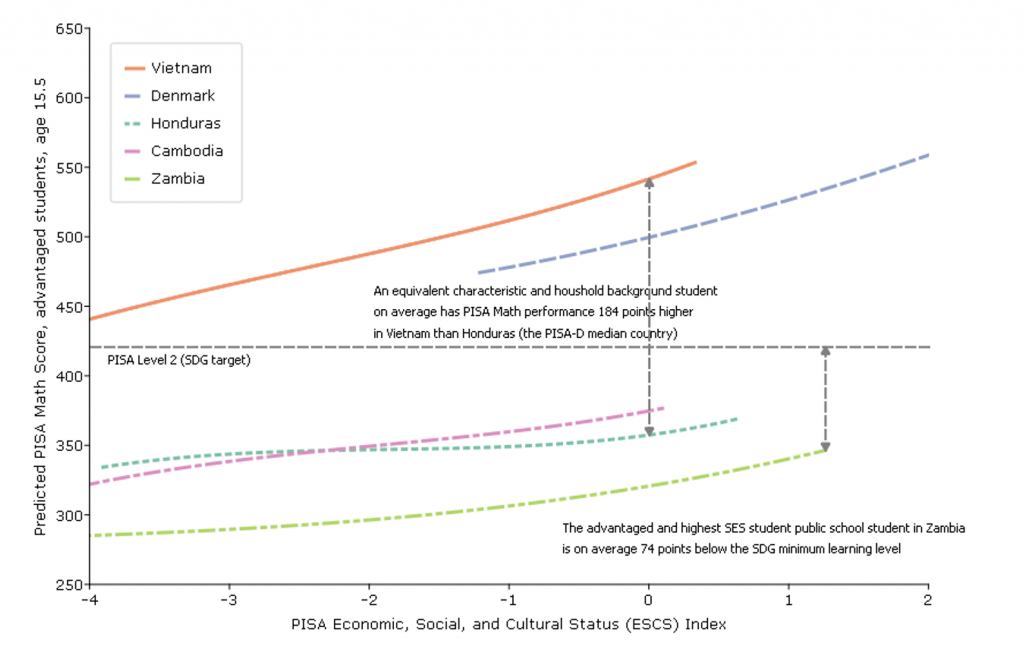Written by Lant Pritchett
Disruptive innovation is the key to long-term excellence, even though its early results are less glamorous than those of approaches that seek to be at the “cutting edge” of innovation.
The term “disruptive innovation” is thrown around a lot in policy discussions about education system reform. However, it is important to recognise that, when this term was introduced by the late Clay Christensen (The Innovator’s Dilemma, 1997), it had a specific meaning which is diametrically opposite to the meaning that many people now ascribe to it. This is not a purely semantic point; the original idea of “disruptive innovation” is a key concept that can help solve the problems facing low performing education systems.
I briefly recap the way in which Professor Christensen used the term and discuss how this concept relates to current debates in the education sector.
Disruptive versus Sustaining Innovation
The key distinction in Christensen’s work was between “sustaining innovation”–which was making the best better—and a “disruptive innovation” that had the following criteria:
(a) it produced worse performance than the existing “cutting edge” technology in meeting the needs of the most demanding users and as judged by the standard metrics used by the industry at the time,
(b) it was cheaper
(c) it adequately met the needs of the many users
(d) although it started from much lower levels of performance, it was on a path of improvement that therefore could meet the demands of more and more users over time.

The idea was that over time firms focused on “sustaining innovation” and exclusively focused on the needs of the highest-end, most demanding, users would become increasingly irrelevant to the needs of most users. Eventually these firms could go bankrupt or disappear–in spite of the fact they were at the “cutting edge” of technology.
An early paradigm example of “disruption” was the personal computer which, when it first appeared, was regarded by the experts in computer science as a toy for hobbyists that had nothing to do with advances in computing as the mainframes at the time were far, far ahead in computing power of the early personal computers. Moreover, improving fast to meet the needs of high-end users was seen as the key element of “good management” that created rapid “sustaining innovation.” Many of the early computing firms were identified as “excellent” companies whose practices should be emulated in the classic management book In Search of Excellence—and yet they went bankrupt in the face of disruption from below.
A key lesson is that firms chasing “best practice” could find themselves increasingly out of touch with what most users wanted. “Cutting edge” technology is not always the path forward for all users, as other approaches are often vastly more cost-effective and meet their actual needs. Not all who wander are lost, and not all who “lead” should be followed.
Implications for global development
Given these descriptions, it is clear that many in the global development community have assumed that their key role was to promote “catch up” of developing countries through the transmission of “sustaining innovation” approaches by transplanting roughly wholesale the approaches and practices of the “developed” countries to the “developing.”
The assumption was that the other countries were close enough behind on the “sustaining innovation” path that this transmission was into contexts similar enough that what worked “here” (Denmark, Chicago, Japan, New Zealand) could be made to work “there” (Delhi, Cambodia, Zambia, Bolivia) and, moreover, that this process of diffusion could be cocooned (more or less) from existing political and social realities and hence this process was more or less “technocratic” and “managerial”. This led to the “solution driven” approach (described well in many different places, like Seeing like a State (James Scott) and Development as an Anti-Politics Machine (James Ferguson)–and hence to the responses when it was realised that the overapplication of “the solution was the problem“.
Of course, there are cases where creating “the solution” globally worked: for example, air travel. International airports all over the world really are amazingly the same and there is a best practice of air traffic control and of aircraft safety that is pretty much the same worldwide (and those of us who travel rely on this).
And there are cases where the solution was the application of a new/known technology which required only logistical implementation (e.g. infant/child vaccinations) and hence for which the basic science did not need to be adapted from place to place, the unit costs could be pushed very low, and the organisational capability for implementation was sufficiently logistical that even pretty low capability governments could do it at scale (and to near universality) and this led to huge improvements in human wellbeing.
But for those of us working on complex and messy public policy issues (such as education) we must surely agree that the “transplantation of sustaining innovation” as a mode of building better government has not worked. We (the global development community) are not 5 years or 15 years or even 25 years into attempts to “build state capability” or “improve government” or “quality education”—we are at least 50 and often 75 years (the time since the political independence of India/Pakistan or Indonesia) into this process (and of course many of the big developing countries have been independent and sovereign even longer).
Therefore it is plausible that disruptive innovation is needed to raise the existing low levels of learning. And that starts by embracing something that is not “best practice,” not on the “sustaining innovation” path, not what the “leading” countries are doing, but rather something which is better adapted to meet the actual needs with the actual resources and capabilities available.
Why do we need disruptive innovation in global education?
Education systems reform provides an excellent example of the limitations of a sustaining innovation approach and the attempt to create improvement only by transplantation. We want to make four points:
1. Attempts to transfer “sustaining innovation” have succeeded in improving school access but not at improving learning
Basic schooling is exactly the “massive success on one hand, failure on the other hand” story where enrolments and grade attainment have expanded massively but learning outcomes have mostly stagnated—and even, in many instances, have gotten much worse. Recent research from Le Nestour, Mosocviz, and Sandefur at CGD using the DHS and MICS surveys estimate the trend in the likelihood that a person who completed exactly Grade 5 can, as an adult, read a single simple sentence in any language of their choosing. Their results are summarised in a recent RISE blog which uses their data to create a graph which shows for each country the very long term changes (roughly 40 or more years between birth cohort estimates) in “Fraction of women completing Grade 5” and “fraction at g=5 who can read” (all countries, with selected countries labelled).
What this graph shows is that in some countries (those in green, like Vietnam) enrolments went up and learning of those at a given level of schooling (Grade 5) got better, but that on average (the black dotted arrow) completion went way up–from 45 percent to 73 percent of the birth cohort completing school–but learning went down (from 78 percent to 64 percent). In some countries (those in red) enrolment/attainment went up but learning went way down. So in Zambia (just as an example, the same is true for many countries) enrolment went up a lot but learning levels of those who completed five years of school declined by around 40 percentage points, such that, in the most recent birth cohort, only about 20 percent of those who completed Grade 5 could read a single sentence as adults.

Source: Adapted from data in de Nestour, Mosocviz, and Sandefur (2020).
The important point is that during this entire period there has been promotion of achieving higher “quality education” and many global actors and donors working in countries like Zambia and Ghana and Cambodia to promote improvements. While there has been success in the logistical parts of building out schools and expanding grade attainment, these efforts have often relied on the promotion of standard “sustaining innovation” approaches to raising quality that applied standard formulas and ideas of what “quality education” meant and how to accomplish that borrowed from current leaders. That process has not led to improved outcomes, but has been consistent (no assertion of causality) with sustained deterioration in learning outcomes for those completing primary education.
2. This is not an inevitable consequence of “poverty” or “lack of development”
The learning gap of those in school at age 15 for “equivalent” kids in socio-economic status between Vietnam and other developing countries is just massive. This graph, adapted from a recent RISE paper, Pritchett and Viarengo 2021) uses the PISA-D data to estimate the PISA scores for the advantaged (male, urban, native speakers of language of instruction/assessment, non-immigrant) kids from different household socio-economic status (based on the PISA constructed index of Economic, Social and Cultural Status (ESCS) based on household assets, parental occupation and education). “Equivalent kids” (on these empirical criteria) in Vietnam are 184 PISA points higher than in Honduras (where 100 PISA points is the standard deviation across all OECD kids, and a “year of schooling” is about 30-40 points).

So no one is saying “poor kids cannot learn” or “poor countries cannot produce high learning”—Vietnam’s students at the same level of socio-economic status outperform those in the OECD (e.g. Denmark).
3. This is not a problem of “exclusion” or “elites” getting a good education and “the poor” not: in poorly performing countries roughly no one is getting a good education.
If you compare in Figure 2 the predicted score of the advantaged, socio-economic elite child to the SDG goal for “minimum level of learning” of reaching PISA level 2, you see that in Zambia the typical advantaged, socio-economic elite kid in public school is far behind the global “minimum” goal—by almost 100 PISA points. So essentially all kids are getting a globally weak education. The socioeconomic lines are upward sloping demonstrating that poorer children are doing worse, but the slope is not that steep relative to the lagging level for all children.
4. Vietnam’s success is not “top down” adoption of “best practice” from a leading country–its achievement was the result of a messy local process.
When our RISE country research team was pressed again and again to explain why Vietnam outperformed other countries by so much (and in the raw PISA results outperformed the US and UK on math) their best answer was “because they wanted to” because the existing “proximate determinants” of success explained so little of the variation (as shown in this RISE paper). (. Moreover, a super interesting recent paper by the political scientist Jonathan London about “outlier Vietnam” cautions against us against our tendency to see success and infer some perfect plan, well executed or the successful “top down” adoption of a “solution” by a centralised, competent bureaucracy. Rather, as with Yuen-Yuen Ang’s account of China’s development success, Vietnam’s experience was super messy at the local level.
What is and is not disruptive innovation in global education?
As discussed earlier, a key feature of disruptive innovation is that at the outset it will deliver outcomes that meet the needs of those who cannot necessarily afford or, with their current capabilities, reach the “best practice.”
Given this, by definition disruptive innovation cannot be about importing the “best practice” approaches which are being used in high performing developed countries. Contrary to popular wisdom, disruptive innovation does not mean access to the internet, or computers for every child, or the teaching approaches of Japan or Finland.
Rather, real disruptive innovation will involve adoption of simpler, more streamlined approaches which, at the outset, will not be seen as sophisticated as education systems in wealthy countries but which will deliver significantly improved education to huge swathes of the world’s population (and which over time will evolve to improve performance).
We have already seen a number of potentially disruptive innovations. One example is the Teaching at the Right Level Approach which was pioneered by Pratham in India. It fits the disruptive innovation definition perfectly in that it is an approach which on the surface is less sophisticated than education approaches used in many rich countries but which, if widely adopted, could transform education in poorer countries. Another example is the “structured pedagogy” approach (Piper et al, 2021) as adopted in the TUSOME program in Kenya and elsewhere.
There is a small but growing global movement for supporting just this type of approach. The RISE Programme will soon be publishing its new Policy Brochure and its key message will be ‘Simplify to Succeed’. It will make the case that to make progress on learning levels, many developing countries will need to focus relentlessly on delivering foundational skills as their first step towards broader educational success. The RISE Community of Practice which includes practitioners from 29 countries, many of them on the front lines of the learning crisis, is actively pushing for this focus on the foundations first. And global organisations including the World Bank, UNICEF, and Save the Children are also increasingly recognising the need to sequence efforts and focus on the foundations first.
Lessons for disruptive innovations in education
Disruptive innovations need to be domestically led as even a disruptive innovation that has proved successful elsewhere will need to be modified and adapted to fit and scale in each new context. Disruptive innovation is not just another “solutionism” but the recognition that each country needs to engage in its own and owned discovery process through something like PDIA (Problem Driven Iterative Adaption) processes.
We need to be frank that this approach receives and will continue to receive a lot of push-back. Many development partners from rich countries seem to assume that the problems facing education systems in their countries somehow must be more or less the same as the challenges facing poor countries and that therefore the solutions must also be similar. Furthermore, policy makers in developing countries are often desperate for modern, high-tech approaches which they hope will allow them to “leapfrog” forward. Conversely, they may have very understandable worries that “disruptive innovation” as described above means consigning their countries to a lesser quality of education. Just as the “leading” computing firms went bankrupt (or nearly so) as they could not adapt their practices to respond to disruption, so too the standard bureaucracies of education resist disruption (e.g. Banerji 2015 about Pratham in Bihar, Aiyar et al 2021 about implementation of Chunauti 2018 in Delhi) .
The key to this movement’s success will be persuading these stakeholders at global and national level that disruptive innovation is not “worse” but better, as it is an achievable first step to build universal access to foundational skills.
When Clay Christensen described disruptive innovation, he pointed out that a key feature is that it might start only able to meet needs of less demanding users than those that sustaining innovation is trying to serve. But to succeed disruptive innovations evolve and improve and eventually surpass the performance of current best practice—but often in radically different ways that the previous “sustaining innovation” would have predicted.
Thus, our call for disruptive innovation is not because we think the children of developing countries deserve a second-class education system. It is because we know that they deserve the best education systems in the world, but their countries cannot get there by simply mimicking what others have done. Instead, countries need to build their own local solutions, starting with disruption.
This blog was first posted on RISE Programme’s website and can be accessed here.
